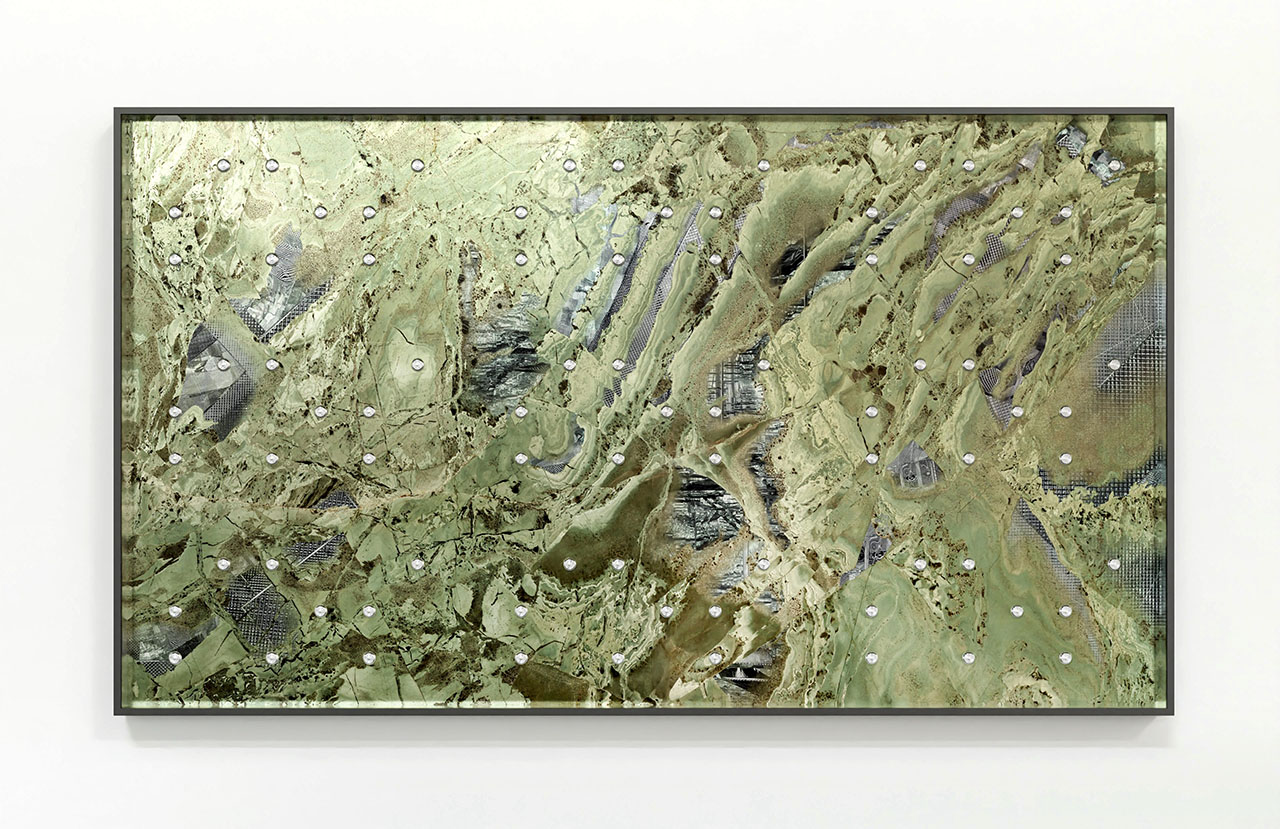[português]
Como o próprio título indica, a obra tem relação com um pedido de
socorro. A sigla SOS está escrita em braile, o que envolveria o tato para
decodificar os pontos em relevo. A artista se vale de círculos de metal
utilizados em sinalização de pisos para alertar deficientes visuais sobre
obstáculos. A mudança de escala dos sinais, em dimensão muito maior do que o
nosso corpo alcança, impede que a leitura ocorra em movimento contínuo e,
assim, é como se as palavras jamais pudessem ser compreendidas. Com a disposição em vertical de um piso tátil
projetado para superfícies horizontais, a inversão das coordenadas de
orientação no espaço pode gerar vertigem. Nosso olhar é atraído em movimentos
espiralados para o interior de espaços imaginários e atordoantes. As imagens
reúnem uma espécie de paisagem construída com fotografias de minerais, que se
mesclam com imagens de grades e fragmentos de arquiteturas labirínticas. A
partir da manipulação de imagens digitais, é como se sobrevoássemos paisagens
convertidas em fósseis que condensam tempos diferentes, como se avistássemos do
alto um território em ruínas, um mundo devastado. As linhas da pedra
fotografada trazem a ideia de fratura, de colapso da natureza e da cultura. As
montagens fotográficas emolduradas são opacas, contrastam com o brilho do
fundo, mas se integram ao conjunto distópico. Os elementos que apontam para a
ideia de futuro são tratados pela artista como algo já sedimentado, como restos
petrificados do passado. Em vez de promessa de felicidade, de crença num mundo
melhor, a obra parece tratar da falência e da impossibilidade de salvação.
[inglês]
As
the title itself indicates, the work is related to a cry for help. The acronym
SOS is written in braille, which would involve touch to decode the raised dots.
The artist uses metal circles used in floor signs
to warn the visually impaired about obstacles. The change in the scale of the
signs, in a much larger dimension than our body can reach, prevents reading
from occurring in continuous movement and, thus, it is as if the words could
never be understood. With the vertical layout of a tactile floor designed for
horizontal surfaces, the inversion of orientation coordinates in space can
generate vertigo. Our gaze is drawn in spiraling movements into imaginary and
dizzying spaces. The images bring together a kind of landscape built with
photographs of minerals, which are mixed with images of grids and fragments of
labyrinthine architecture. From the manipulation of digital images, it is as if
we were flying over landscapes converted into fossils that condense different
times, as if we were looking down on a territory in ruins, a devastated world.
The lines of the photographed stone convey the idea of fracture, of the
collapse of nature and culture. The framed photographic montages are opaque,
contrasting with the brightness of the background, but are integrated into the
dystopian set. The elements that point to the idea of the future are treated by
the artist as something already settled, as petrified remains of the past.
Instead of promising happiness, believing in a better world, the work seems to
deal with bankruptcy and the impossibility of salvation.
Cauê Alves, 2021
 Campo Fraturado SOS I, 2022. Impressão com tinta pigmentada mineral sobre papel Hahnemühle 340g, aço inox, madeira e alumínio. 126 x 221 x 7 cm. Edição única. Créditos: ©Pedro Perez Machado.
Campo Fraturado SOS I, 2022. Impressão com tinta pigmentada mineral sobre papel Hahnemühle 340g, aço inox, madeira e alumínio. 126 x 221 x 7 cm. Edição única. Créditos: ©Pedro Perez Machado.  Campo Fraturado SOS I, 2022. Créditos: ©Pedro Perez Machado.
Campo Fraturado SOS I, 2022. Créditos: ©Pedro Perez Machado.  Campo Fraturado SOS II, 2022. Impressão com tinta pigmentada mineral sobre papel Hahnemühle 340g, aço inox, madeira e alumínio. 126 x 221 x 7 cm. Edição única. Créditos: ©Pedro Perez Machado.
Campo Fraturado SOS II, 2022. Impressão com tinta pigmentada mineral sobre papel Hahnemühle 340g, aço inox, madeira e alumínio. 126 x 221 x 7 cm. Edição única. Créditos: ©Pedro Perez Machado.  Campo Fraturado SOS II, 2022. Créditos: ©Pedro Perez Machado.
Campo Fraturado SOS II, 2022. Créditos: ©Pedro Perez Machado. 